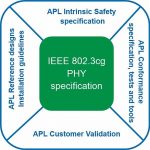Today’s control systems don’t make it easy to connect supplementary tools, such as those for optimisation, because an engineering process is generally necessary for integration. Accessing a sensor via the control system’s controller normally entails a lot of effort. Since it is not desirable to modify an operable system, most people choose not to bother. Yet to many users, this situation just isn’t good enough. At the same time, incorporating this data in asset management, condition monitoring or other IT systems requires higher bandwidths and Ethernet support. It is very likely that these requirements will increase again in the context of digitalisation and Industry 4.0.
This is why a whole host of concepts and processes enabling access to the data in question have been developed over the last few years. One current example of this is NOA (the Namur open architecture concept), which allows monitoring and optimisation applications to be initially integrated as a prototype, for a limited time only or permanently without having to engineer the system.
Ethernet-based communication technolo-gies like Profinet are a crucial pillar of future automation designs, as they are responsible for the secure transmission of information. By using industry-specific profiles, Profinet is also able to provide the data with semantics, so that it takes on useful meaning. Profinet facilitates the integration not only of other networks, such as upstream or downstream production steps like packaging lines, but also of diagnostic and maintenance tools or additional, individual sensors. The advantage here is that Profinet can work with such a wide variety of networks whereas the user has only one.
With OPC UA, the connection to higher levels is very easy to implement without an additional network on account of the NOA. For a long time now, PI has been cooperating with the OPC Foundation with the goal of utilising OPC UA in PI technologies. The FDI specification actively promoted by PI in cooperation with the FieldComm Group uses OPC UA services, for example. The OPC UA for Devices specification which is already established there is also used to map Profinet. Thanks to the TCP/IP channel in Profinet networks, which is traditionally open, OPC UA access to lower-level devices is possible via the controllers and gateways or even directly.
An OPC UA Profinet companion specification targeted for completion in mid-2019 is currently in preparation. Device manufacturers can continue to integrate proven Profinet services; information on OPC UA services can then be displayed in the relevant devices according to the defined mapping and depending on the customer’s requirements.
Process-specific requirements
This isn’t the only way that Profinet has been adapted to the specific needs of the process industry over the past five years, though. Cyclic and acyclic data exchange, the integration of fieldbus systems using proxies, time synchronisation and time stamping, diagnostics and redundancy or configuration of the system on the fly are likewise possible. The industry’s characteristic requirements have meanwhile also been integrated into Profinet Tester, which is used to carry out automated test runs at accredited PI test laboratories by testing both the interface functionality’s conformity with the standard and the interoperability of devices from multiple manufacturers.
New paths in hazardous areas
Every step was carried out in very close cooperation with Namur. This will also apply to the next set of tasks when field devices with a Profinet interface are made accessible to explosion-protected areas.
A little background information is needed here: the use of Ethernet-based interfaces with field devices for process instrumentation, for example when explosion protection requirements must be taken into account, has its limitations. Apart from explosion protection, the process industry also needs two-wire communication. Segment lengths of up to 1000 m are necessary in large-scale chemical plants, and the process sensors and actuators must be powered via the two-wire connection parallel to communication (loop power).
Since it makes sense to standardise this kind of development, numerous representatives from production, process and building automation, as well as PHY manufacturers, got together to initiate an IEEE call for interest in July 2016. Just six months later, the IEEE 802.3cg Task Force was ready to start work on the specification of a new standard. Based on this, ASIC manufacturers can now develop an Ethernet PHY which is suitable for an array of applications like the building, manufacturing and process industries.
The special challenges of explosion protection cannot be solved by IT experts, however. This is why the three organisations – FieldComm Group (FCG), ODVA and PI (Profibus & Profinet International) – as well as eleven industry partners of the APL (Advanced Physical Layer) project have taken up the gauntlet. On the one hand, an APL interface with a very low energy requirement is called for to enable intrinsically safe field devices to be implemented. DEKRA EXAM is presently collaborating on this. On the other, this interface must be designed in such a way that it is still economical. After all, there are thousands upon thousands of very simple temperature and pressure transmitters at any chemical facility, so that expensive interfaces simply aren’t realistic here.
The APL project thus supports the current work of the IEEE 802.3cg Task Force. The framework for the new Ethernet standard has already been defined: a data rate of 10 Mbps, simultaneous transmission and reception via a two-wire line (full-duplex communication) and optional an power supply to connected terminal devices over the same line (power over data line).
One central task of the APL project team is to ensure the interoperability of APL components. This includes specifying intrinsically safe communication and supply as well as the associated profiles, so that industrial Ethernet field devices can be used in hazardous areas up to Zone 0 or Class 1/ Division 1. Ensuring the conformity of these devices, and hence their interoperability, is likewise a top priority.
Working together with users
In the meantime, conformance and EMC tests are already being defined, guidelines for installation and test scenarios developed and reference implementations addressed. The APL team now needs to install a pilot as soon as possible, so as to gain experience with the new technology together with users. The first certified APL devices are expected in 2021.
Online search: cpp0218profibus
Hall11.0, Booth C43












